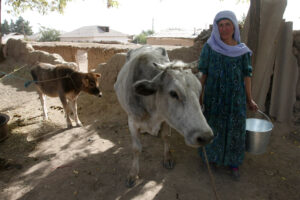Livestock related emergencies, including conflict or disease induced crises, are becoming increasingly widespread. Their effects can be devastating on families, communities and whole countries, with serious economic and social consequences felt long after emergencies end. To help protect national and global food security as well as smallholder farmers’ livelihoods, the Food and Agriculture Organization of the United Nations (FAO) and the Livestock Emergency Guidelines and Standards (LEGS) published a desk review covering 25 years of lessons learned from livestock-related emergencies and response in Eastern Europe and Central Asia.

23 October 2010, Oksu – A woman farming carrying away fresh milk as part of a FAO project improving food security in rural Tajikistan through enhanced livestock production and pasture rehabilitation © FAO
In the rural areas of Eastern Europe and Central Asia, livestock is an integral part of the household economy and contributes significantly to family subsistence, livelihoods, and nutrition. Agriculture can severely affected by natural disasters. Also, man-made conflicts hamper livestock production and often result in the loss of animals
When animals are safe and healthy, chances increase for farmers to survive a crisis and rebuild their livelihoods.
The in-depth review uncovers which actions and approaches work best to protect and support livestock-keeping communities affected by emergencies.
“For the sustainability of the interventions, the review found that it is essential to combine timely humanitarian assistance with a medium to long term development and a resilience-building approach,” said Tibor Szűcs, FAO livestock production specialist.
“This valuable resource not only highlights the importance of timely, targeted interventions but also reinforces our commitment to supporting the resilience of those who rely on livestock for their livelihoods. Together, we can ensure that emergency responses are more effective, sustainable, and aligned with the unique needs of these communities,” commented Suzan Bishop, LEGS Technical and Project Manager. “Livestock Emergency Guidelines and Standards is continuing to improve humanitarian support in current emergencies in the region. Recently, LEGS delivered a presentation, co-chaired by FAO, to the Agriculture Technical Working Group of the Food Security and Livelihoods Cluster in Ukraine.”
Learning from livestock emergencies of the past
The review presents nine cases of three types of emergencies (slow, rapid onset, and complex). Each is presented according to its impact on smallholder livestock farmers, and the scope, scale, and type of any FAO intervention. Where possible, the study also looks at the effectiveness of the interventions for these farmers, drawing links to the LEGS Core Standards that guide best practice in supporting livestock-reliant communities facing emergencies.
As an example of a slow onset emergency, the publication looks at the effect of several droughts on Moldovan livestock farmers and the efficiency of FAO’s emergency livestock assistance, including the distribution of livestock feed.
Drought, being a slow onset emergency, leaves sufficient time for the government and the private sector to react and implement appropriate food insecurity and poverty preventive measures, for which they have received further support from FAO.
Rapid onset emergencies hit more unexpectedly and require more prompt reactions. To see how these can unfold and what possible measures can limit the damages and losses, the publication reviews the major flood of 2014 in Southeast Europe, as well as the earthquake in Albania, and the assistance provided that combined emergency relief activities with trainings.
As their name suggests, complex emergencies require a more nuanced approach. Complex emergencies are multifaceted crisis in a context in which there is a breakdown of authority that can adequately respond to and cope with resolving the crisis. Often, there are simultaneously civil conflict and natural shocks. In Eastern Europe and Central Asia, FAO has taken action to support communities during numerous complex emergencies. A few examples illustrate the complexity of the social, political, environmental and humanitarian crises and interventions that followed. In war-stricken Donbas, in Ukraine, critical livestock inputs of various types, including farming equipment, were distributed to smallholders to restore production. To counter the impact of the Kosovo1 crisis of the late nineties, FAO helped restock livestock and improve the animal health support system. In Tajikistan, extreme weather events from 2006 to 2008 made many smallholder farmers sell productive assets, including livestock, which led to further decreases in production. The emergency support of FAO aimed to reestablish livestock production capacity and enhance livestock reproduction.
These projects have been assessed against eight key criteria, known as the LEGS Core Standards: participation; preparedness; technical support and agency competencies; initial assessment and response identification; technical analysis and intervention; monitoring, evaluation, and livelihoods impact; policy and advocacy; and monitoring. The LEGS Core Standards highlight the most important factors that can ensure an impactful, inclusive, and sustainable intervention.
1All references to Kosovo shall be understood to be in the context of UN Security Council resolution 1244 (1999).

